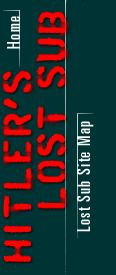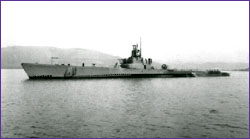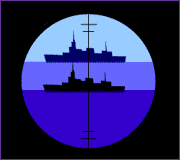
|

|
Imagine that you're the skipper of a WWII submarine. Let's say it's the USS Cod, a submarine that saw service from 1943 to 1945, and you're on the prowl for enemy ships. What is it that you're supposed to do? How do you go about finding and firing at a target? The first thing you need to do is situate your boat underwater at the right depth. For the USS Cod, you'd level off at the submarine's periscope depth, which is 67 feet. You'd then use your search periscope to scan the horizon. The search periscope's wide field of view allows you to see a wide area all at once. Then you see it. An enemy destroyer. You switch to the attack periscope. The attack periscope is much smaller—its neck, the part that slices through water, is only 1.4 inches in diameter, so it leaves hardly any wake as the boat moves along. Next up is determining the target's bearing, course, range, and speed. To get the bearing, you center the scope's crosshairs on the ship. You call out "mark!"; the executive officer reads out the position off a gauge on the periscope. You determine the ship's course by guessing its "angle on the bow." For example, if the ship is heading directly toward you, the angle on the bow is 0 degrees. If its left side is facing you, the angle on the bow is "90 degrees port."
Even though the sonar isn't sending out pings, your sonar operator is busy. He's hunched over his equipment, listening to the enemy ship. With stopwatch in hand, he determines the rate at which the enemy ship's props turn. "One hundred and twenty five per minute," he announces. This tells you that its speed is 9 knots (about 10mph). The navigation officer has been busy, too. He's been listening to you and the crew and setting the dials of the TDC—the Torpedo Data Computer. The TDC is a strictly mechanical computer that relies on dials and gears. There are two sections to the TDC. One is the position keeper, which keeps track of the target, in real time, relative to your position. The navigation operator has entered the target's bearing, course, range, and speed. The TDC also keeps track of your position—it automatically enters in the submarine's speed and heading and makes adjustments whenever you change speed or heading. The other section of the TDC is the angle solver. The angle solver looks at your position and the position of the target and calculates the course the torpedo must take to strike the target. This would be a simple calculation if the submarine were pointed directly at the target, if the path of the torpedo were a straight line, and if the target were stationary. But the submarine doesn't need to be pointed at the target because the torpedo has a gyroscope, and the gyroscope controls the direction in which the torpedo travels. So, the angle solver calculates the angle, or heading, that the torpedo would need to take to reach that strike point, taking into consideration the torpedo's speed, its reach (the torpedo does travel in a straight line after leaving its tube for a set distance; this is called its reach), and the curved path that happens between the end of the reach and when the gyroscope tells the torpedo that it's on course. You could fire one or more torpedoes now—the gyros of each of the torpedoes in your 10 torpedo tubes are aimed at the target—but you know that if you're patient, you'll have a better chance of making a strike because you'll be able to fine tune the TDC settings. You lower the periscope. You wait 15 minutes. You raise the periscope again. You compare the target's calculated position to its actual position. How far off is the TDC? You make adjustments, then lower the periscope again. More waiting. One more comparison, you think, between the predicted and actual position should do it. You raise the periscope. The TDC is right on. Now you're ready to fire! But you don't give the command, as this is just an exercise. To fire torpedoes, you'll have to go to Sink the Ship. How a Torpedo Works Firing Procedure Sink the Ship requires the free Shockwave plug-in Photo: (1) Courtesy of John Fakan, PhD; Skipper, USS Cod. Tour U-869 | Sole Survivor | Hazards of Diving Deep 400 Years of Subs | Map of Lost U-Boats | Fire a Torpedo Resources | Transcript | Site Map | Hitler's Lost Sub Home Editor's Picks | Previous Sites | Join Us/E-mail | TV/Web Schedule About NOVA | Teachers | Site Map | Shop | Jobs | Search | To print PBS Online | NOVA Online | WGBH © | Updated November 2000 |
 USS Cod
USS Cod
 View through attack periscope.
View through attack periscope.